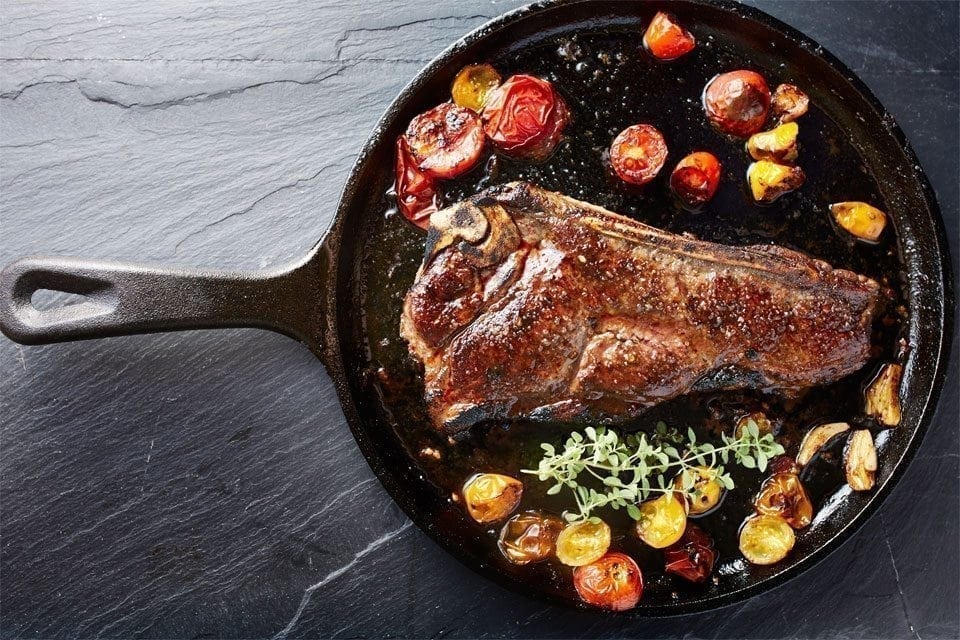All cattle is grass-fed most of its life. Yet most beef comes from cattle “finished” on feedlots with a diet of various grains, roughage and nutritional supplements for the last 120-200 days to fatten it up and limit muscle development creating more tender meat before slaughter.
Grass-fed beef is theoretically grass-fed its entire life and comes with a health halo, as well as accompanying higher price tag. Let’s break that down.
NOT ALL LABELS ARE EQUAL
Only some food labels are regulated, and many of them don’t mean quite what you might think. In terms of beef, here are a few to know:
1. GRAIN-FED BEEF (AKA CONVENTIONAL BEEF)
While regulated by the USDA, this label simply means no preservatives or artificial ingredients have been added. When talking about raw beef, this label is essentially meaningless.
2. NATURAL BEEF
Instead of natural, look for “naturally raised,” which is a USDA certification that the meat comes from cattle that never received growth hormones, antibiotics or animal by-products. Both “natural” and “naturally raised” beef can be grain- or grass-fed.
3. CERTIFIED ORGANIC
This beef is from cattle fed 100% organic feed, either from grass or grain, with access to pasture and never given hormones or antibiotics.
4. GRASS-FED BEEF
It used to be that grass-fed beef came from cattle raised on a pasture, and fed only grass or forage once they were weaned. On January 12, 2016, the USDA nixed its grass-fed labeling program and no longer defines this term. Apparently, only four grass-fed beef producers nationwide adhered to the USDA standard.
SO WHAT DOES GRASS-FED MEAN?
You can still find “grass-fed” beef at the store, but the USDA no longer defines or regulates it.
The USDA says the handful of users of its grass-fed label must now do one of three things. First, they can adopt the USDA’s existing standard as their own. Second, they can develop their own standard. Or, third, they can rely on an existing private labeling standard. Notably, these private certifiers have been among those who pointed out many of the limitations of the USDA standards.
“The USDA definition does a good job of defining what grassfed animals can and cannot be fed,” the Food Alliance writes. “But it does not deal with other issues consumers care about—like the use of hormones and antibiotics, confinement of animals and environmental stewardship.”
Which labels have some meaning? According to Consumer Reports, beef labeled “grass-fed” by American Grassfed, NOFA-NY, PCO Certified or AGW means the beef (or dairy product) comes from animals that were 100% grass-fed as certified by an independent third party.
HOW GRASS-FED BEEF STACKS UP
The USDA Nutrient Database shows that, per 3-ounce (85g) serving, grass-fed beef has about 20 calories fewer than grain-fed beef, roughly 2 less grams of total fat and 1 more gram of protein. Both types of beef provide all 10 essential nutrients, including iron, zinc and B vitamins.*
Nonetheless, proponents of grass-fed beef claim the cattle’s grass-only diet imbues its meat with higher levels of vitamins A and E (associated with lower inflammation) and omega-3 fats.
A 2008 study by Leheska et al,** found that every 3-ounce (85g) serving of grass-fed beef contained 26 milligrams of omega-3 fats compared with 2.4 milligrams in the same amount of grain-fed beef. While this may sound like a lot, it’s actually not a huge difference if you look at the omega-3 fats recommendations by the National Academy of Medicine, which are 1,100 mg for women daily and 1,600 mg for men. In this context, if you’re trying to get more omega-3’s in your diet, shoot for foods high in those fats like fatty fish, flaxseeds and walnuts.
FINAL VERDICT
When it comes to choosing beef to suit dietary needs, it may be less important to think about the diet of the cattle and more important to focus on the cut. Regardless of whether beef is grass-fed or grain-fed, choose lean cuts for optimal nutrition. There are 29 cuts of beef on the market that are classified as “lean,” meaning they have less than 10 grams of fat, less than 4.5 grams of saturated fat and less than 95mg of cholesterol per 3.5-ounce (98g) serving. At the store, look for the words “loin” or “round” in the name to ensure you’re selecting a healthier option. Other delicious lean cuts include flank, strip, T-bone and chuck shoulder steaks.




